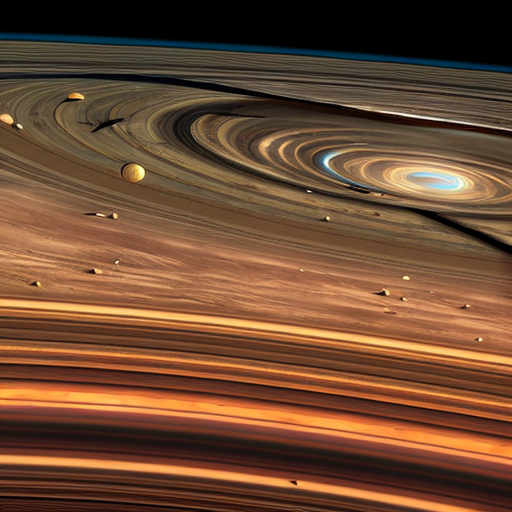
Exploring the Enigmatic Surface of Saturn: A Journey Through the Ringed Planet’s Mysteries
The planet Saturn has long fascinated astronomers with its striking rings and beautifully hued atmosphere. But it is not just its outer appearance that is intriguing. Saturn’s surface is equally enigmatic, with a range of features that hint at a complex history of geological activity and dynamic changes.
Ringed Wonder: The Saturn System
Saturn’s impressive rings are perhaps its most famous feature, spanning more than 280,000 kilometers wide – over twice the size of the planet itself. They are a collection of icy particles, ranging from tiny grains to boulder-sized chunks, that orbit around Saturn in a tight formation. The rings are divided into distinct sections, with brighter and more clearly-defined zones called “gaps” separating darker regions known as “bands”.
The origin of Saturn’s rings is still a matter of debate among scientists. Some theories suggest that they formed from the remains of a moon that was pulled apart by its gravitational force, while others propose that they were the result of a collision with a smaller object. Regardless of their origin, the rings continue to provide a wealth of information for planetary scientists.
Exploring Saturn: Missions to the Ringed Planet
Over the past few decades, several spacecraft missions have been sent to explore Saturn and its moons up close. The first was the Pioneer 11 spacecraft, launched by NASA in 1973. It flew by Saturn in 1979, taking the first close-up images of the planet and its rings.
The Voyager program, which consisted of two spacecraft, Voyager 1 and Voyager 2, also flew by Saturn in 1980 and 1981. These missions provided detailed images of Saturn’s rings and helped to uncover some of the secrets of the planet’s interior.
The Cassini-Huygens mission, launched in 1997, was the most ambitious mission to Saturn to date. The spacecraft spent over a decade studying the planet and its moons, providing unprecedented insights into the composition and behavior of Saturn’s rings and atmosphere.
What Lies Beneath: The Surface of Saturn
While we know a great deal about Saturn’s atmosphere and rings, we know relatively little about its actual surface. This is because Saturn doesn’t have a solid surface in the same way that Earth does – its surface is made up of gases that gradually become denser as you move deeper into the planet.
However, some features on Saturn’s surface are visible from space, including its polar hexagon and pole vortex. The hexagon is a six-sided shape that has been observed at Saturn’s north pole, while the vortex is a swirling storm that occurs at the south pole.
Another intriguing feature of Saturn’s surface is its moon Enceladus, which has a water vapor plume emanating from its south pole. This has led to speculation that the moon may harbor a subsurface ocean, making it a potential target for future exploration.
The Future of Saturn Exploration
Despite the wealth of information we have gathered about Saturn and its system, there is still much to learn about this fascinating planet. In the coming years, several new missions are planned to explore Saturn and its moons.
One of these is the Europa Clipper mission, which will fly by Jupiter’s moon Europa. Although not a direct mission to Saturn, its findings may have important implications for our understanding of Saturn’s moons and their potential for harboring life.
Another mission in development is the Dragonfly mission, which will explore the surface of Saturn’s moon Titan using a small rotorcraft. This mission is being designed to study Titan’s geology and search for signs of life.
As we continue to explore Saturn and its system, we are sure to uncover more of the mysteries that lie beneath its beautiful exterior.
